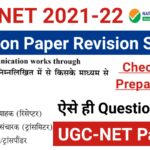Results
Congratulations 🎉🎉🎉🎉🎆
Its Ok Take test Again !
#1. In which method of research an independent variable is manipulated with an intent to observe concomitant changes in dependent variable?
Experimental research is a study that strictly adheres to a scientific research design.
 Key Points
Key Points
- Experimental research consists of a hypothesis, a variable that the researcher can manipulate, and variables that can be measured, calculated, and compared.
- Most importantly, experimental research is carried out in a controlled setting.
- The researcher gathers data, and the findings will either support or refute the hypothesis.
- This research method is known as hypothesis testing or deductive research.
 Important Points
Important Points
- The aim of experimental research is to find a relationship between two variables: the dependent variable and the independent variable.
- A correlation between a specific aspect of an entity and the variable being studied is either supported or rejected after an experimental research study is completed.
Thus In an experimental method of research an independent variable is manipulated with an intent to observe concomitant changes in dependent variable.
#2. Given below are two statements Statement I : Sample sizes for qualitative research vary by technique but are generally small. Statement II : Qualitative research involves non-probability sampling. In light of the above statements, choose the correct answer from the options given below
 Key Points
Key Points
Statement I: Sample sizes for qualitative research vary by technique but are generally small.
Qualitative research:
- The data are generally nonnumerical.
- Qualitative research can be used to understand how an individual subjectively perceives and gives meaning to their social reality.
- For example, a convenience store wanted to determine why women were not visiting the store so it can conduct an in-depth interview of potential customers in the category.
- Thus the goal of qualitative research is not to disprove a hypothesis, but we’re looking to understand the nature of a problem in detail.
- Qualitative research doesn’t try to make quantitative claims that generalize to the whole target audience.
- Hence the sample requirement for qualitative research is small.
- Techniques used for Qualitative research rely on data obtained by the researcher from first-hand observation, interviews, questionnaires, focus groups, participant-observation, recordings made in natural settings, documents, case studies, and artifacts
Hence statement I is correct.
Statement II: Qualitative research involves non-probability sampling.
Non-probability sampling techniques
- These are often used in exploratory and qualitative research.
- In these types of research, the aim is not to test a hypothesis about a broad population but to develop an initial understanding of a small or under-researched population
- The goal of qualitative research is not to disprove a hypothesis, but we’re looking to understand the nature of a problem in detail Hence non-probability sampling is utilized for Qualitative research
Hence statement II is correct.
Therefore we conclude that the correct answer is both Statements I and Statement II are true.
#3. The term “research methodology” refers to
Research methodology refers to the techniques used to find and analyze information for a study, ensuring that the results are valid, reliable and that they address the research objective. It is the theoretical paradigms for data collection, analysis, and interpretation.
 Important PointsResearch Methodology:
Important PointsResearch Methodology:
- Research methodology is a way of explaining how a researcher intends to carry out their research.
- It’s a logical, systematic plan to resolve a research problem.
- A methodology details a researcher’s approach to the research to ensure reliable, valid results that address their aims and objectives.
- It encompasses what data they’re going to collect and where from, as well as how it’s being collected and analyzed.
 Additional Information
Additional Information
For example, steps involved in research methodology by the researcher.
- What data to collect (and what data to ignore)
- Who to collect it from (in research, this is called “sampling design”)
- How to collect it (this is called “data collection methods”)
- How to analyze it (this is called “data analysis methods”)
Therefore, the term “research methodology” refers to the methods used in data collection and analysis.
#4. Identify the main features of qualitative research from the following : (A) It is concerned with understanding the phenomena from the participant’s perspective. (B) It assumes that there are social facts with a single objective reality. (C) Researcher becomes immersed in the situation, present or past. (D) Researcher is detached from the study to avoid bias. (E) There is greater flexibility in both the methods and research process. Choose the correct answer from the options given below :
Qualitative research is research using methods such as participant observation or case studies that result in a narrative, descriptive account of a setting or practice.
 Key points
Key points
The main features of qualitative research are:
- It is a naturalist approach that seeks an understanding of social phenomena.
- It deals with human behavior from an informant’s perspective.
- This type of research analyzes non-numeric data.
- It focuses on the ‘why and what’ of social phenomena.
- Inductive in approach.
- It has a Post Positivist approach.
- It is concerned with understanding the phenomena from the participant’s perspective.
- The researcher becomes immersed in the situation, present or past.
- There is greater flexibility in both the methods and the research process.
- Biases of the researcher are quite evident in this type of research.
Hence, (A), (C), and (E) are the main features of qualitative research.
#5. In which of the following research methods, manipulation and control of variables, and randomization of sample are two of the basic requirements?
| Research methods | Description |
| Ex-post facto research |
|
| Descriptive research |
|
| Case study research |
|
| Experimental research |
|
#6. Which one of the following is the main feature of qualitative research?
Research is a systematic inquiry towards understanding a complex social phenomenon or a process. They are broadly categorized into qualitative and quantitative research. Based on the research problem, the selection of research methods by the researcher may vary.
 Key Points
Key Points
Positivistic Research Paradigm:
A research paradigm is a research model or a perceptual orientation for conducting research that has been verified by the research community.
- Emphasizes quantitative analysis over qualitative analysis
- Relies heavily on experimentation
- Subscribes to pre-existing categories
- Hypotheses are put forward about the causal relation between phenomena
- Empirical evidence is gathered and analysed that explains the effect of the independent variable on the dependent variable
- Employs a deductive approach to analyse data
- Collects numerical data
#7. Identify which of the following steps are carried out for constant comparison in grounded theory research?
Grounded theory is a well-known methodology employed in many research studies. Qualitative and quantitative data generation techniques can be used in a grounded theory study. Grounded theory is credited to Glaser and Strauss as its creators. The constant comparative method is a process developed by Glaser and Strauss and used in grounded theory,
 Key PointsThe steps required for constant comparison are as follows
Key PointsThe steps required for constant comparison are as follows
Data collection, note taking, coding, and memoing.
- Data collection: Data collection is the process of gathering and measuring information on variables of interest, in an established systematic fashion that enables one to answer stated research questions, test hypotheses, and evaluate outcomes.
- Note-taking: Note-taking is, simply, a way of concisely recording important information so that you can recall it later.
- Coding: If someone is working on a new topic that has very limited literature to build on, you may not be able to find established theories that allow you to develop the coding categories in advance. In this case, the emergent coding approach, based on the notion of grounded theory, is appropriate.
- Memoing: Memoing refers to the process where researchers make. notes while exploring the data
Thus, the steps carried out for constant comparison in grounded theory research are data collection, note-taking, coding, and memoing.
#8. Given below are two statements Statement I: If we are interested in the worldview of members of a certain social group, a qualitative research strategy that is sensitive to how participants interpret their social world may be preferable. Statement II: If a researcher is interested in a topic on which little or no research has been done in the past, quantitative research may be easy to employ because there is little prior literature from which to draw leads. In light of the above statements, choose the most appropriate answer from the options given below
 Important PointsStatement I: If we are interested in the worldview of members of a certain social group, a qualitative research strategy that is sensitive to how participants interpret their social world may be preferable.
Important PointsStatement I: If we are interested in the worldview of members of a certain social group, a qualitative research strategy that is sensitive to how participants interpret their social world may be preferable.
- The objective of qualitative research is to obtain participants’ experiences of life events.
- It enables researchers to obtain insights into what it feels like to be another person and to understand the world as another experience it.
- Research in qualitative methods has historically been employed in fields such as sociology, history, and anthropology.
Therefore, statement I is correct.
Statement II: If a researcher is interested in a topic on which little or no research has been done in the past, quantitative research may be easy to employ because there is little prior literature from which to draw leads.
- The literature review is an important step to complete while doing any research, whether quantitative or qualitative.
- It is a major myth that quantitative research may be easy to employ in research where there is little prior literature.
Therefore, Statement II is incorrect.
Therefore, the correct answer is Statement I is correct but Statement II is incorrect.
#9. Match List I with List II : List I Type of validity List II Reflection (A) Face Validity (I) Indicates adequacy of instrument (B) Concurrent validity (II) Indicates the extent to which the measurement is used (C) Construct (III) Compares a new test to an already established test. (D) Predictive (IV) The extent to which a score on a scale forecasts scores on same criterion measure Choose the correct answer from the options given below :
Validity is one of the important characteristics of scientific research. The term ‘Validity’ implies truth or fidelity. Thus, validity refers to the degree to which a test measures what it claims to measure. The word “valid” is derived from the Latin ‘validus’. A Valid measurement is always reliable.
- For determining the validity of a test, the test should be compared to another independent construct or criteria.
- Validity is concerned with generalizability.
- Validity has three important properties:
- It is a relative term.
- It is not a fixed concept or criteria of a test because it is an unending process that requires constant validation.
- It is just a measure concept and not an all-or-none property.
 Important Points
Important Points
| Validity | Description |
| Face Validity |
|
| Concurrent validity |
|
| Construct Validity |
|
| Predictive Validity |
|
#10. Which of the following is common in all true experimental and Quasi experimental designs?
The correct option is the Control group.
There are two basic types of research design:
- True experiments
- Quasi-experiments
The purpose of both is to examine the cause of certain phenomena.
 Key Points
Key Points
- True experiments, in which all the important factors that might affect the phenomena of interest are completely controlled, are the preferred design.
- Often, however, it is not possible or practical to control all the key factors, so it becomes necessary to implement a quasi-experimental research design.
- control group, the standard to which comparisons are made in an experiment.
- Many experiments are designed to include a control group and one or more experimental groups; in fact, some scholars reserve the term experiment for study designs that include a control group.

















Good work mam
Thank You !